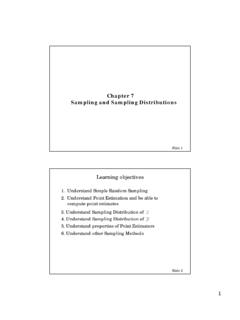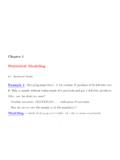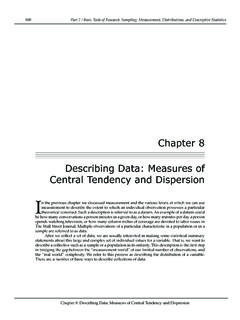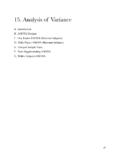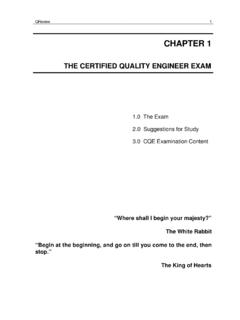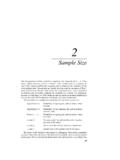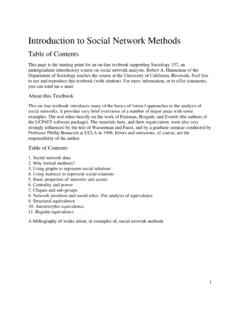Transcription of Chapter 9 Distributions: Population, Sample and Sampling ...
1 119 Part 2 / Basic Tools of Research: Sampling , Measurement, Distributions, and Descriptive StatisticsChapter 9 Distributions: population , Sampleand Sampling DistributionsIn the three preceding chapters we covered the three major steps in gathering and describingdistributions of data. We described procedures for drawing samples from the populations wewish to observe; for specifying indicators that measure the amount of the concepts contained inthe Sample observations; and, in the last Chapter , ways to describe a set of data, or a this Chapter we will expand the idea of a distribution , and discuss different types of distri-butions and how they are related to one another. Let us begin with a more formal definition of theterm distribution :A distribution is a statement of the frequency with which units of analysis (or cases) are as-signed to the various classes or categories that make up a refresh your memory, a variable can consist of a number of classes or categories.
2 The vari-able Gender , for instance, usually consists of two classes: Male and Female; Marital Communi-cation Satisfaction might consist of the satisfied , neutral , and dissatisfied categories, and Time Spent Viewing TV could have any number of classes, such as 25 minutes, 37 minutes, and anumber of other values. The definition of a distribution simply states that a distribution tells us howmany cases or observations were seen in each class or instance, a Sample of 100 college students can be distributed in two classes which make upthe variable Ownership of a CD Player . Every observation will fall either in the owner or non-owner class. In our example, we might observe 27 students who own a CD player and a remain-ing 73 students who do not own a CD player. These two statements describe the 9: Distributions: population , Sample and Sampling Distributions120 Part 2 / Basic Tools of Research: Sampling , Measurement, Distributions, and Descriptive StatisticsThere are three different types of distributions that we will use in our basic task of observationand statistical generalization.
3 These are the population distribution , which represents the distribu-tion of all units (many or most of which will remain unobserved during our research); the sampledistribution, which is the distribution of the observations that we actually make, after drawing asample from the population ; and the Sampling distribution , which is a description of the accuracywith which we can make statistical generalization, using descriptive statistics computed from theobservations we make within our DistributionWe ve already defined a population as consisting of all the units of analysis for our particularstudy. A population distribution is made up of all the classes or values of variables which we wouldobserve if we were to conduct a census of all members of the population . For instance, if we wish todetermine whether voters Approve or Disapprove of a particular candidate for president, thenall individuals who are eligible voters constitute the population for this variable.
4 If we were to askevery eligible voter his or her voting intention, the resulting two-class distribution would be a popu-lation distribution . Similarly, if we wish to determine the number of column inches of coverage ofFortune 500 companies in the Wall Street Journal, then the population consists of the top 500 com-panies in the US as determined by the editors of Fortune magazine. The population distribution isthe frequency with which each value of column inches occurs for these 500 observations. Here is aformal definition of a population distribution :A population distribution is a statement of the frequency with which the units of analysis or cases thattogether make up a population are observed or are expected to be observed in the various classes or catego-ries that make up a the emphasized phrase in this definition.
5 The frequency with which units of analysis areobserved in the various classes of the variable is not always known in a population if we conduct a census and measure every unit of analysis on some particular characteristic(that is, actually observe the value of a variable in every member of the population ) will we be ableto directly describe the frequencies of this characteristic in each class. In the majority of cases wewill not be in a position to conduct a census. In these cases we will have to be satisfied with drawinga representative Sample from the population . Observing the frequency with which cases fall in thevarious classes or categories in the Sample will then allow us to formulate expectations about howmany cases would be observed in the same classes in the example, if we find in a randomly selected (and thus representative) Sample of 100 collegeundergraduates that 27 students own CD players, we would expect, in the absence of any informa-tion to the contrary, that 27% of the whole population of college undergraduates would also have aCD player.
6 The implications of making such estimates will be detailed in following distribution that results from canvassing an entire population can be described by usingthe types of descriptive indicators discussed in the previous Chapter . Measures of central tendencyand dispersion can be computed to characterize the entire population such measures like the mean, median, mode, variance and standard deviation of a popu-lation distribution are computed, they are referred to as parameters. A parameter can be simplydefined as a summary characteristic of a population distribution . For instance, if we refer to the factthat in the population of humans the proportion of females is .52 (that is, of all the people in thepopulation, 52% are female) then we are referring to a parameter. Similarly, we might consult atelevision programming archive and compute the number of hours per week of news and publicaffairs programming presented by the networks for each week from 1948 to the present.
7 The meanand standard deviation of this data are population probably are already aware that population parameters are rarely known in communica-tion research. In these instances, when we do not know population parameters we must try to ob-tain the best possible estimate of a parameter by using statistics obtained from one or more samplesdrawn from that population . This leads us to the second kind of distribution , the Sample 9: Distributions: population , Sample and Sampling Distributions121 Part 2 / Basic Tools of Research: Sampling , Measurement, Distributions, and Descriptive StatisticsSample DistributionAs was discussed in Chapter 5, we are only interested in samples which are representative ofthe populations from which they have been drawn, so that we can make valid statistical generaliza-tions.
8 This means that we will restrict our discussion to randomly selected samples . These randomprobability samples were defined in Chapter 6 as samples drawn in such a way that each unit ofanalysis in the population has an equal chance of being selected for the Sample is simply a subset of all the units of analysis which make up the population . Forinstance, a group of voters who Approve or Disapprove of a particular presidential candidateconstitute a small subset of all those who are eligible voters (the population ). If we wanted to deter-mine the actual number of column inches of coverage given to Fortune 500 companies in the WSJ wecould draw a random Sample of 50 of these companies. Below is a definition of a Sample distribu-tion:A Sample distribution is a statement of the frequency with which the units of analysis or cases thattogether make up a Sample are actually observed in the various classes or categories that make up we think of the population distribution as representing the total information which wecan get from measuring a variable, then the Sample distribution represents an estimate of this infor-mation.
9 This returns us to the issue outlined in Chapter 5: how to generalize from a subset of obser-vations to the total population of ll use the extended example from Chapter 5 to illustrate some important features of sampledistributions and their relationship to a population distribution . In that example, we assumed thatwe had a population which consisted of only five units of analysis: five mothers of school-agedchildren, each of whom had differing numbers of conversations about schoolwork with her child inthe past population parameters are presented in Table 9-1, along with the simple data array fromwhich they were derived. Every descriptive measure value shown there is a parameter, as it is com-puted from information obtained from the entire 9: Distributions: population , Sample and Sampling Distributions122 Part 2 / Basic Tools of Research: Sampling , Measurement, Distributions, and Descriptive StatisticsChapter 9: Distributions: population , Sample and Sampling Distributions123 Part 2 / Basic Tools of Research: Sampling , Measurement, Distributions, and Descriptive StatisticsBut we know that a Sample will contain a certain amount of Sampling error, as we saw inChapter 5.
10 For a refresher, see Table 5-6 in that Chapter for a listing of all the samples and theirmeans that would be obtained if we took samples of N = 3 out of this population . Table 9-2 showsjust three of the 125 different Sample distributions that can be obtained when we do just the observed values in the three samples are not identical, the means, variances, andstandard deviations are different among the samples , as well. These numbers are not identical to thepopulation parameters shown in Table 9-1. They are only estimates of the population values. There-fore we need some way to distinguish between these estimated values and the actual descriptivevalues of the will do this by referring to descriptive values computed from population data as param-eters, as we did above.

